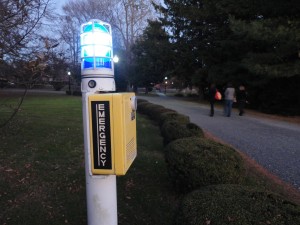By Hannah Gonneville –
Sleeping on the thinly carpeted floor of a cafeteria is not exactly an ideal way to celebrate Halloween. However, some University of Hartford students had no choice but to spend the holiday on the hard floor, wrapped in blankets.
During the recent snowstorm and subsequent power outage, university RAs evacuated students from their dark dorms. Advised to pack an overnight bag, students journeyed to the Gengras, the school’s cafeteria.
Instead of dressing up as witches, football players, or Lady Gaga, students spent Halloween attempting to fall asleep under the bright cafeteria lights. While the evacuation upset and even angered some students, the University needed to put the students’ safety first.
With more and more unusual weather outbreaks occurring, other universities must also prepare to manage these types of emergencies.
Like the University of Hartford, Salve Regina also has plans in place to deal with major power outages or dangerous storms.
“What we do depends on each situation,” says the Vice President of University Relations, Kristine Hendrickson. If the University is aware of an incoming storm, they send an email a day or two in advance, suggesting preparation methods, she says. In addition to emails, the university is currently developing its emergency alert system. The system now includes a text service, which will alert students about winter storms and cancelled classes.
The school is also looking at ways to alert students of emergencies if technology fails. “We always try to have a Plan B,” says Hendrickson.
She says the school is looking into an internet server that is not housed on campus. If the power goes out, administrators
can still send emails to students’ cell phones and post important updates on the university’s website.
Thinking outside the realm of the internet, Salve is also developing a more simplistic alert system. “We’re looking into a system of using the chapel bells,” Hendrickson says.
With such a system, the school would develop a way for students to recognize the bells and understand their message. It would involve some training, but would work whether or not the school’s technology was functioning.
Earlier this fall during hurricane Irene, Salve Regina faced a situation similar to the University of Hartford. With the risk of high winds and flooding, athletes, RAs and other students on campus for the summer were relocated to Miley’s cafeteria and dormitory section.
Before the storm hit, administrators warned students of the evacuation, and kept students updated about the storm’s status. Usually, the school evacuates students to Rogers Recreation, but due to the smaller number of people, it was more conducive to keep people in Miley, where the cafeteria and other facilities were easily accessible, says Hendrickson.
Hendrickson also stressed that teamwork is essential when carrying out emergency plans, such as the one implemented during the hurricane. Alyssa Desmarais, an RA in her junior year at Salve, says, “As an RA, my responsibility is to make sure my residents are safe and well.”
During the storm, Desmarais and the other RAs helped students evacuate the dorms, close the dorm windows and lock up valuables.
As administrators made sure the students were safe, the RAs kept their peers entertained.
“To pass time, we played card games, board games, had sing-alongs with several talented guitar players and vocalists, colored inside the lines of coloring books, and stayed well-fed with Miley’s one working oven,” says Desmarais.
After being secured in Miley from Friday till Tuesday, students felt restless, but no one was harmed by broken power lines or fallen trees.
Desmarais even managed to discover a positive side of the situation. “Although most of us had no more clean clothes, had forgotten towels to shower with, had dead cell phones and had a bad case of cabin fever, all in all, it was a very rewarding experience,”
she says.
Hendrickson believes that her team handled the situation well, but the recent storm also showed her certain areas that need to be improved upon. The university also offered shelter to their off-campus students, and tried to keep students as informed as possible.
“This is a community, if someone needs help, we’re going to help them the best we can,” says Hendrickson.















